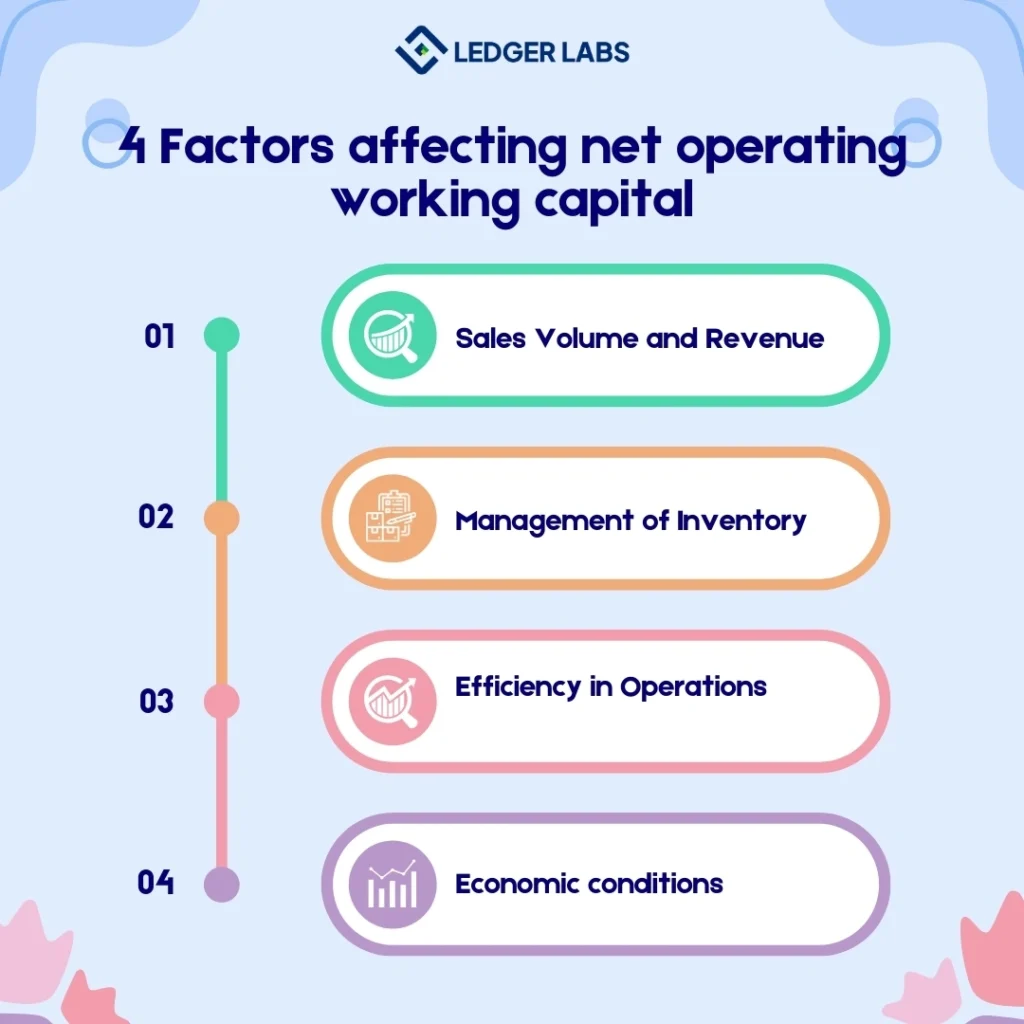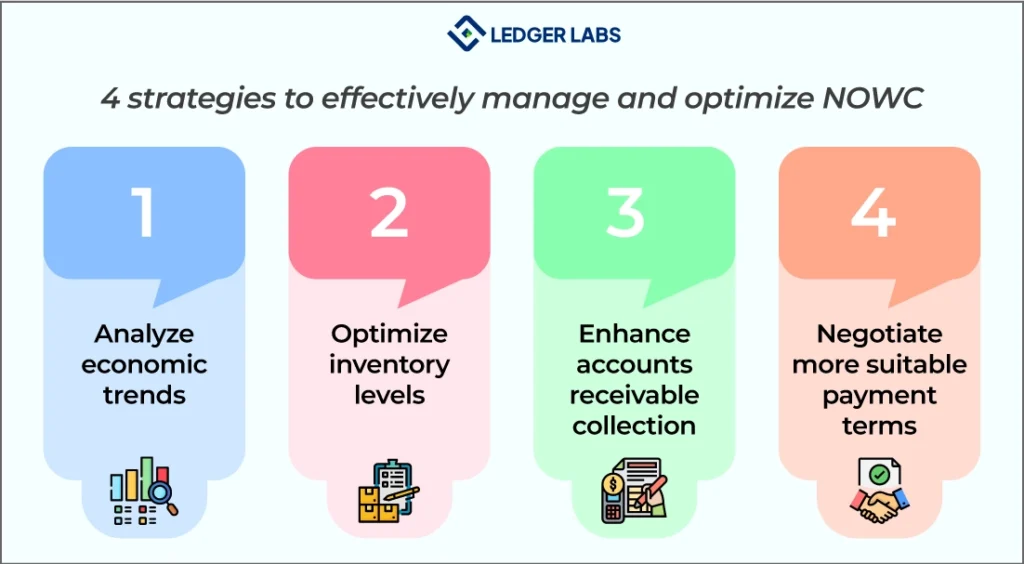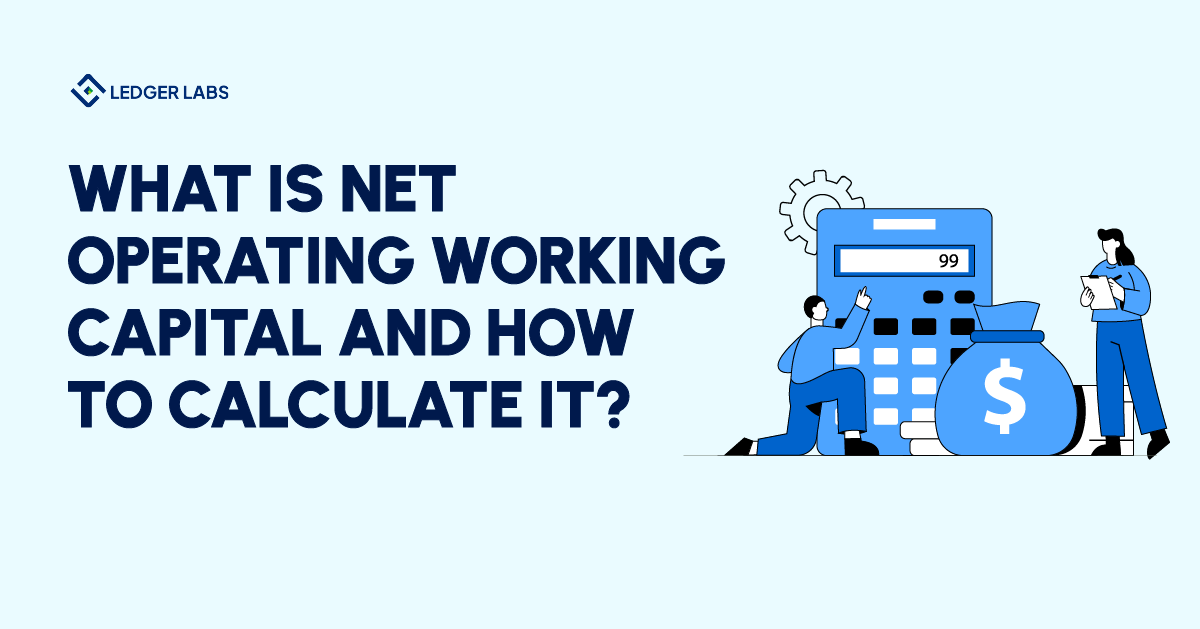1. Net Operating Working Capital (NOWC) measures a company’s short-term liquidity and operational efficiency by calculating the difference between operating current assets and operating current liabilities.
2. NOWC includes accounts like receivables, inventory, and payables but excludes non-operational items like short-term loans or marketable securities. It focuses solely on operational efficiency.
3. A positive NOWC indicates healthy liquidity and operational efficiency, allowing companies to manage short-term obligations effectively and sustain operational growth.
4. NOWC = (Current Assets – Non-operating Assets) – (Current Liabilities – Non-operating Liabilities). Adjusting for non-operational items is key.
NOWC is a critical instrument that sheds light on the business’s short-term financial well-being.
The concept helps you calculate the difference between a company’s current assets and liabilities (leaving out cash and its equivalents).
This is the money a business uses daily (not just the money they can set aside for major purchases like investments).
In other words, net operating working capital shows us how a business has managed its everyday money matters. We can also say that it acts as a piggy bank for a company’s daily expenses. But, why is it important, and what factors affect it?
Let’s talk about this in detail.
Why is net operating working capital important?
A good net operating working capital indicates that a company has enough potential to fund its daily operations without relying on additional funding from different sources. Further, it is a big sign of financial stability and greater operational efficiency. It is also important because it:
- Attracts investors and lenders: One of the most significant benefits of a net operating working capital is that it helps lenders and investors analyze whether a business has a lower insolvency risk.
- Helps in business comparison: Net operating working capital is a very beneficial tool that lets you compare various businesses, mainly those in the same sector. In the words of investors, analysts, and lenders – NOWC helps them see which companies manage their money better in their daily operations.
- Helps plan better: Any company can plan better with just one comprehensive look at the net operating working capital. Considering the bar is high, it means the business has extra money to grow or invest. But, what happens if it’s low? Well, that can mean the company needs to be more careful with their expenses.
Difference between working capital and net operating working capital
While it’s true that both of these terms help understand a company’s short-term financial well-being, there’s still a fundamental difference in their internal meanings.
1. Working Capital: It is a broader concept, including current assets and liabilities, regardless of whether it relates to operations. In layman’s language, this comprises insights about short-term debt and cash reserves that aren’t necessarily part of a company’s daily operations.
2. Net Operating Working Capital: Conversely, NOWC mainly deals with operational aspects. It’s majorly a way to look at how a company is financially performing right now. In general, it gives a view of components indirectly related to the business’s core activities. Usually, this enables us to gain more focused insights regarding operational liquidity.
Related Articles:
- How to calculate retained earnings on a balance sheet?
- Post tax deductions simplified: What are they and how do they work?
- What is Financial Leverage Ratio and why is it important for small businesses?
- Catch Up Bookkeeping: A Comprehensive Guide!
- Strategic Planning KPIs: Who are the major players?
- Controller For Small Business – Who Are They & How They Work?
Net operating working capital calculation
If you want to get a clear method of how to calculate net operating working capital then you need to understand what happens behind the scenes. That means you have to be aware of the company’s day-to-day financial health.
However, let us see the net operating working capital formula:
NOWC = Cash + Accounts Receivable + Inventory – (Accounts Payable + Accrued Expenses) Thus, we can evaluate NOWC by deducting a company’s operating current liabilities from its current assets.
Identifying the different components of net operating working capital
As seen in the formula above, these are components of net operating working capital:
1. Operating current assets: A company uses these types of assets to fund its day-to-day operations. In fact, they can quickly turn it into cash in a year. Its types are:
- Accounts receivable (AR): This is the amount customers owe a business.
- Inventory: These are items or goods ready to be sold.
2. Operating current liabilities: As part of its daily operations, this is usually a pile of debt or obligations a company needs to pay back in a year. Operating current liabilities comprise Accounts Payable (AP), where a business owes money to one or more than one supplier. Also included are accrued expenses that is expense recognized, but not yet paid.
How to calculate net operating working capital?
Here are the steps you’ll need to calculate NOWC:
- Determine current assets: These are assets a company can efficiently and quickly turn into cash within only a year. This comprises Accounts Receivable, prepaid expenses, and items ready to be sold (inventory). If you look closely at a balance sheet, you will likely see these details up close.
- Identify current liabilities: These are the debts or bills a business needs to pay back in one year. For instance, these can be bills to be paid to suppliers (accounts payable), accrued expenses, and any short-term loans. Luckily, this information can be found on a balance sheet, too.
- Exclude cash and its equivalents: Since cash and its equivalents do not really contribute to a company’s daily operations, they are usually excluded from net operating working capital.
- Evaluating NOWC: In order to determine the net operating working capital, consider the current assets (excluding cash and similar items) and deduct it from current liabilities. Remember, you need to exclude any short-term debt that funds the current assets).
Now that you have a definitive answer, you know better how well a business is doing with its money.
Example to illustrate NOWC calculation process:
Let’s say, for example, the AR of a company is $30,000, along with its inventory, $20,000. In addition, its AP is $15,000.
Therefore, we know that:
Operating Current Assets: $30,000 (Accounts Receivable) + $20,000 (Inventory)
Hence, $30,000 + $20,000 = $50,000
Moreover, its Operating Current Liabilities: $15,000 (Accounts Payable)
Thus, with the help of the above information, we can easily determine the NOWC of the business.
It is: NOWC = $50,000 – $15,000 = $35,000
Understanding the significance and interpretation of NOWC
If you ask what is net operating working capital, we will say it’s a measurement metric that gives a brief sneak peek into a company’s operational health. But, beyond that, many more areas need equal coverage. One of them is the net operating working capital ratio.
It is typically evaluated by dividing NOWC by a company’s total sales of assets. This ratio gives a better picture of how effectively a business uses its working capital in relation to its sales or size. When compared against market benchmarks or past figures in the company, you can monitor whether it is rising, declining, or neutral in working capital management.
Understanding the implications of positive and negative NOWC
A positive NOWC is a good sign, showing that the company owns more operational assets than liabilities. In other words, it means that the company has the power to cover its operations without needing additional financing. This goes to show how efficient and stable the business is.
On the contrary, a negative NOWC indicates that the company’s operational liabilities are actually exceeding its assets. As a result, this could be a significant red flag for potential liquidity concerns or increased reliance on debt for daily operations.
Nonetheless, NOWC can directly reflect a business’s liquidity because it touches several pointers. For example, it shows how readily a company can meet its short-term obligations.

Factors affecting net operating working capital
A number of operational factors affect Net Operating Working Capital. Here’s a rundown of factors that impact NOWC:
- Sales Volume and Revenue: Any increase in sales can result in greater accounts receivable (AP). This, in turn, affects NOWC. In reverse, a plunge in sales can likewise decrease NOWC.
- Management of Inventory: This is where you get a clear picture about how much inventory a business holds and how effectively it turns over inventory. In simple words, a quick turnover indicates that a business is rapidly selling its goods. In reality, it is a good sign because it frees up the capital looped in inventory.
- Efficiency in Operations: Faster production cycles or efficient supply chain management typically have a positive impact on NOWC. This means that it minimizes the need for an increased level of receivables and inventory.
- Economic conditions: At certain times, broader economic conditions, including industry demand and interest rates can also impact NOWC via sudden changes in inventory costs, credit terms, and sales.
How changes in inventory, accounts receivable, and accounts payable affect NOWC?
Let’s break it down into three-pointers to make the concept more precise:
- Inventory: Assuming an increase in inventory, it can raise NOWC because more capital is tied up in stock. On the flip side, effective inventory management that minimizes stock levels can reduce NOWC.
- Accounts Receivable: If the AR (Accounts Receivable) is higher, it can increase NOWC. This is a clear indication that money is tied up with customers.
- Accounts Payable: An increment in Accounts Payable (AP) can decrease NOWC. In other words, it frees up more operational capital.
4 strategies to effectively manage and optimize NOWC
There are some strategies you can use in your favor to manage and optimize NOWC. Some of the major strategies are listed for you:
- Analyze economic trends: Closely examine market trends and additional economic indicators to understand future changes in sales or expenses. This can help big-time in proactive adjustments to NOWC components.
- Optimize inventory levels: Always leverage inventory management techniques to minimize the overflow of stocks, thus freeing up capital.
- Enhance accounts receivable collection: If a business manages its inventory well (i.e., not holding surplus or insufficient stock of the products it sells), this may impact the funds available for day-to-day operations.
- Negotiate more suitable payment terms: Try to work with suppliers and negotiate a longer payment term. Why? Because this can largely help you reduce NOWC by retaining money a little longer in the business.

Importance of monitoring and managing NOWC
Keeping a close eye on your business’s net operating working capital is super important. Here’s why:
Role of NOWC in Cash Flow Management
- Cash flow control: NOWC is basically an umbrella term that gives a sneak peek into how much money a company has for its day-to-day operations. Assuming that net operating working capital is managed really well, there’s no doubt that the company can always have enough cash to pay bills, buy supplies, and help the business stay on track.
- Anticipating cash needs: If you look closely at the net operating working capital, you can predict the time when it will require more cash. Therefore, this can help you plan ahead of time and prevent unwanted surprises.
How does net operating working capital affect profitability and operational efficiency?
If you have good net operating working capital management, there’s a good chance that it can lead to better profits. As a result, this can mean that the company has little money tied up in things like unpaid bills or products that are still to be sold.
In addition, efficient net operating working capital management can also contribute to smoother day-to-day operations. To put it simply, it ensures there are always adequate stocks to sell and bills that can be paid right on time.
Related Articles:
- Heads-up Small Business Owners: 9 Accounting Trends to Watch Out for in 2024!How to calculate retained earnings on a balance sheet? Earnings?
- What is a financial audit and how to prepare for it?
- What is a GL code and how to automate it?
- What is bad debt expense and how to estimate it?
- What’s Cost Volume Profit Analysis? Assumptions, Examples, and Calculations
- Property Management Accounting: A Complete Starter Guide
In wrapping up
If you are not keeping a close eye on your company’s net operating working capital, you might face trouble. NOWC is a vital metric that helps you understand the cash flow of a company, its profitability, and how well it manages its daily business.
It is a key factor that gives a fuller picture of your business and can help you understand if there is sufficient capital for your company to run well on profits. Very frankly, it is not about the numbers on the sheet anymore. Instead, it is about keeping your business afloat, healthy, and ready for growth.
No matter how big or small your business is, if you want to stay ahead of the curve, then you must pay attention to your company’s net operating working capital. Or our expert accountants and bookkeepers at the Ledger Labs can help you do it, why not schedule a meeting and speak with us!












